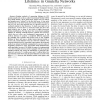Free Online Productivity Tools
i2Speak
i2Symbol
i2OCR
iTex2Img
iWeb2Print
iWeb2Shot
i2Type
iPdf2Split
iPdf2Merge
i2Bopomofo
i2Arabic
i2Style
i2Image
i2PDF
iLatex2Rtf
Sci2ools
71
Voted
INFOCOM
2007
IEEE
2007
IEEE
Residual-Based Measurement of Peer and Link Lifetimes in Gnutella Networks
—Existing methods of measuring lifetimes in P2P systems usually rely on the so-called Create-Based Method (CBM) [16], which divides a given observation window into two halves and samples users “created” in the first half every ∆ time units until they die or the observation period ends. Despite its frequent use [2], [17], [19], this approach has no rigorous accuracy or overhead analysis in the literature. To shed more light on its performance, we first derive a model for CBM and show that small window size or large ∆ may lead to highly inaccurate lifetime distributions. We then show that create-based sampling exhibits an inherent tradeoff between overhead and accuracy, which does not allow any fundamental improvement to the method. Instead, we propose a completely different approach for sampling user dynamics that keeps track of only residual lifetimes of peers and uses a simple renewal-process model to recover the actual lifetimes from the observed residuals. Our analysis i...
Communications | INFOCOM 2007 | Residual Lifetimes | So-called Create-based Method | Ultrapeer Lifetimes |
| Added | 03 Jun 2010 |
| Updated | 03 Jun 2010 |
| Type | Conference |
| Year | 2007 |
| Where | INFOCOM |
| Authors | Xiaoming Wang, Zhongmei Yao, Dmitri Loguinov |
Comments (0)

